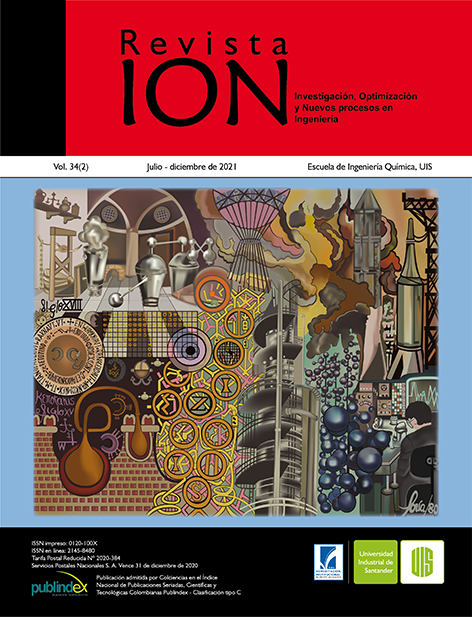Published 2021-08-11
Keywords
- DO Transfer,
- Anoxic water,
- Paddle wheel aerator,
- Energy consumption
How to Cite
Abstract
The reduction of dissolved oxygen (DO) in water is associated with the effect of climate change. The lack of oxygen in water bodies directly affects the biological species present in different shallow water bodies such as swamps and wetlands, as well as in aquaculture processes. An optimal value in the DO concentration favors the reproduction of these biological species present in both artificial and natural environments. For this, various equipment has been developed to favor the increase of DO in the water to acceptable values. However, some of these systems are expensive, energy inefficient, and noisy which generate adverse impacts in aquatic ecosystems due to perturbances in the water. This study measures the efficiency (KgO2·kWh-1) of introducing DO into the water using a paddle wheel aerator system at low RPMs destined for shallow bodies of water. Tests were performed on anoxic water samples using aerators with 6, 12, and 24 paddles at the laboratory level. By increasing the voltage (6, 9, and 12V), the RPMs applied to each device through a geared motor is also increased. The results show a higher DO transfer rate in the 1 and 5 mg of O2·L-1 range. The best configuration concerning energy consumption worked at low RPMs using the 6-paddle wheel aerator at 6V. This establishes that, in addition to the management of low revolutions, the use of a smaller number of wheels favors an increase in efficiency during the DO restoration process in shallow water bodies.
Downloads
References
[2] Itano T. et al. Water circulation induced by mechanical aerators in a rectangular vessel for shrimp aquaculture. Aquac. Eng. 2019;85:106–113. doi: 10.1016/j.aquaeng.2019.03.006.
[3] Ren AS, Chai F, Xue H, Anderson DM, and Chavez FP. A Sixteen-year Decline in Dissolved Oxygen in the Central California Current. Sci. Rep. 2018;8(1):1–9. doi: 10.1038/s41598-018-25341-8.
[4] Torres A, Quintero J, and Atehortúa L. Determination of the specific oxygen uptake rate in microorganisms including electrode time response. Rev. Fac. Ing. Univ. Antioquia. 2018;43:33–41.
[5] Bao W, Peng Z, Zhou D, Zhu S, and Ye Z. Performance evaluation of an intensive pond aquaculture system for commercial freshwater fish production. 2018:3–12. doi: 10.13031/aim.201801093.
[6] He Z, Petiraksakul A, and Meesapya W. Oxygen-Transfer Measurement in Clean Water. J. KMITNB. 2003;13(1):4–19.
[7] Arora S, Keshari AK. Estimation of re-aeration coefficient using MLR for modelling water quality of rivers in urban environment. Groundw. Sustain. Dev. 2018;7:430–435. doi: 10.1016/j.gsd.2017.11.006.
[8] Rojas Romero JA. Tratamiento de aguas residuales. Teoría y principios de diseño, 3rd ed. Bogotá. Colombia: Escuela Colombiana de Ingeniería, 2010.
[9] Mueller J, Boyle WC, Popel HJ. Aeration: principles and practice, 1st ed., vol. 11. Boca Raton, Filadelfia, USA, 2002.
[10] Inaba H. “Floating type energy saving water cleaning apparatus,” 3360075, 2005.
[11] Brown TW, Tucker CS. Pumping Performance of a Modified Commercial Paddlewheel Aerator for Split-Pond Aquaculture Systems. N. Am. J. Aquac. 2014;76(1):72–78. doi:10.1080/15222055.2013.860067.
[12] Suravut S, Hirunlabh J, Khedari J, Kiddee K. Stand Alone Water Wheel Low Speed Surface Aerator Chaipattana RX-2-3, Controller System. Energy Procedia. 2017;138:751–755. doi:10.1016/j.egypro.2017.10.214.
[13] Brown TW, Tucker CS, Rutland BL. Performance evaluation of four different methods for circulating water in commercial-scale, split-pond aquaculture systems. Aquac. Eng. 2016;70:33–41. doi: 10.1016/j.aquaeng.2015.12.002.
[14] Becker A, Whitfield AK, Cowley PD, Järnegren J, Næsje TF. Does boat traffic cause displacement of fish in estuaries?. Mar. Pollut. Bull. 2013;75(1–2):168–173. doi: 10.1016/j.marpolbul.2013.07.043.
[15] Balazik MT, et al. The Potential for Vessel Interactions with Adult Atlantic Sturgeon in the James River, Virginia. North Am. J. Fish. Manag. 2012;32(6):1062–1069. doi:10.1080/02755947.2012.716016.
[16] Uby L. Next steps in clean water oxygen transfer testing – A critical review of current standards. Water Res. 2019;157:415–434. doi: 10.1016/j.watres.2019.03.063.
[17] Blanco-Zuñiga CR, Rojas-Arias N, Peña-Pardo LY, Mendoza-Oliveros ME, Martinez- Ovalle SA. Study of the influence of clays on the transfer of dissolved oxygen in water. Ingeniería. 2021;26(1):1–8. doi: https://doi.
org/10.14483/23448393.15846.
[18] Cogate PR, Beenackers AA, Pandit AB. Multipleimpeller systems with a special emphasis on bioreactors: a critical review. Biochem. Eng. J. 2000;6:109–144.
[19] Blanco-Zúñiga C, Rojas-Arias N. Dissolved oxygen transfer using flatandcurves paddlewheel on a mechanical aerator. Prospectiva. 2021;19(1):1–10. doi: http:://doi.org/10.15665/rp.v19i1.2527.
[20] Ahmad T, Boyd CE. Design and peroormance of paddle wheel aerators. Aquac. Eng. 1988;7(1):39–62. doi: 10.1016/0144-8609(88)90037-4.
[21] Roy SM, Moulick S, Mal BC. Design Characteristics of Spiral Aerator. J. World Aquac. Soc. 2017;48(6):898–908. doi: 10.1111/jwas.12410.
[22] Abdelrahman HA, Boyd CE. Effects of mechanical aeration on evaporation rate and water temperature in aquaculture ponds. Aquac. Res. 2018;49(6):2184–2192. doi: 10.1111/ are.13674.
[23] Sander R. Compilation of Henry’s law constants (version 4.0) for water as solvent. Atmos. Chem. Phys. 2015;15(8):4399–4981.
[24] Bahadori A, Vuthaluru HB. Simple Arrhenius-type function accurately predicts dissolved oxygen saturation concentrations in aquatic systems. Process Saf. Environ. Prot. 2010;88(5):335–340. doi: 10.1016/j.psep.2010.05.002.
[25] Killgore KJ et al. Fish Entrainment Rates through Towboat Propellers in the Upper Mississippi and Illinois Rivers. Trans. Am. Fish. Soc. 2011;140(3):570–581. doi:10.1080/00028487.2011.581977.
[26] Quirós P. Determinación de modelos para la predicción de los coeficientes volumétricos de transferencia de masa (k L a) oxígeno-medio de cultivo en biorreactores tipo tanque agitado. Universidad de Costa Rica, 2014.
[27] Stenstrom MK, (Ben) Leu SY, Jiang P. Theory to Practice: Oxygen Transfer and the New ASCE
Standard. Water Environ. Found. 2006;4838–4852.
[28] Armstrong MS, Boyd CE. Oxygen Transfer Calculations for a Tractor-Powered Paddlewheel Aerator. Trans.Am.Fish.Soc.1982;111(3):361–366. doi:10.1577/1548-8659(1982)111<361:OTCFAT>2.0.CO;2.
[29] Moulick S, Mal BC. Performance Evaluation of Double-Hub Paddle Wheel Aerator. J. Environ. Eng. 2009;135(7):562–566. doi: 10.1061/ (asce)0733-9372(2009)135:7(562).
[30] Moulick S, Bandyopadhyay S, Mal BC. Design Characteristics of Single Hub Paddle Wheel Aerator. J. Environ. Eng. 2005;131(8):1147–1154. doi: 10.1061/(ASCE)0733-9372(2005)131:8(1147).
[31] Bahri S, Jufriadi, Anwar H. The Ineffectiveness of Water Splash on Paddlewheel Aerator,” IOP Conf. Ser. Earth Environ. Sci. 2019;268:012-162. doi: 10.1088/1755-1315/268/1/012162.


